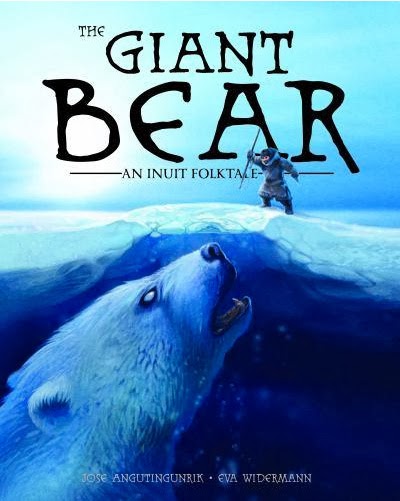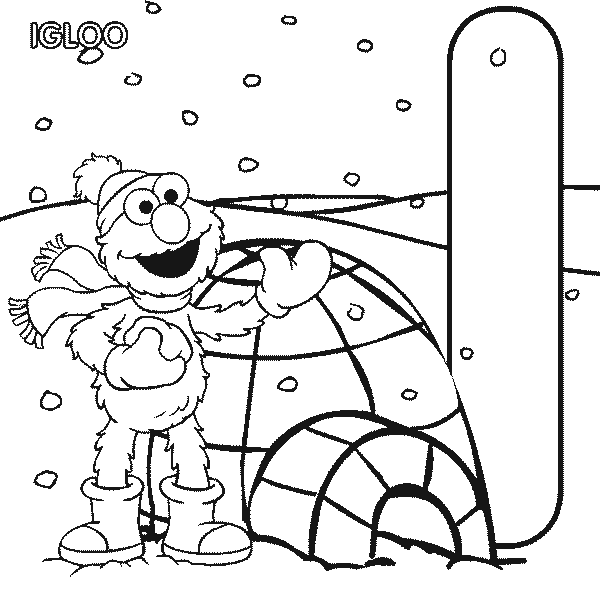 |
Canku Ota
|
 |
|
(Many Paths)
|
||
|
An Online Newsletter
Celebrating Native America
|
||
|
February 2014 - Volume
12 Number 2
|
||
|
|
||
|
THE GIANT BEAR: AN
INUIT FOLKTALE
by Jose Angutinngurniq |
||
|
by Debbie Reese - American
Indians in Children's Literature
|
||
|
For starters, the book opens with a two-page foreword about Inuit stories that tell of giant creatures of long ago. One of those giant creatures is nanurluk, which means giant bear. The story in The Giant Bear is about how a hunter kills a nanurluk. The foreword provides a lot of context for the story, situating it within the people from whom the story originates. Second is the word iglu. It is one of four words (nanurluk is another) included in a Pronunciation Guide that follows the foreword. It means "A winter dwelling made with snow blocks" (n.p.). In parenthesis we see how the word is pronounced. For iglu, we see "igloo." I'm taking time to point out iglu/igloo because this tiny bit of information is one of the reasons I think The Giant Bear is terrific. I'd love to see every book use iglu instead of igloo. If I was still teaching, in fact, I would physically alter "igloo" in books I had in my classroom, and I'd make sure I taught my students to use iglu instead of igloo. Third is Eva Widermann's illustrations. Here's a gorgeous illustration from the book. It is the third reason that I'm so taken with The Giant Bear:
See how big the iglu is in comparison to the man and woman? That iglu is where they are living for this story. In another illustration, you see them inside where she is cooking and he's stretched out on a bench. Next time you see an illustration or a toy iglu that is out-of-scale, you could take a minute and point out that error. Below is an example from a Sesame Street coloring book. See what I mean?
Fourth is the story Angutinngurniq (the author) tells. The Inuit man in the story is out hunting one day and comes across what he recognizes as an aglu, which is a breathing hole in sea ice that is created or kept open by a marine animal. He knows that the nanurluk comes out that hole to hunt, too, and decides he has to take action to protect his winter camp (the iglu) from the nanurluk. His plan is a clever one that gives him an edge so that he can kill the nanurluk. The method by which he kills the bear is what some people find troubling about the book. Using his harpoon, he stabs the nanurluk's eyes and nose when it starts to emerge from the hole. Without its ability to see and smell, it dies. Widermann accurately depicts that part of the story. Some think it is too graphic for a young reader, but that depends on the reader. Those for whom hunting is part of their experience won't struggle with it. That is precisely what Erin said in her review of the book at the Goodreads site. Here's her review again:
Inhabit Media prepared a study guide. It consists of a series of lesson plans teachers can use along with the book. I especially like the one about Climate Change. It starts on page 27 of the guide and includes watching a PBS Jean-Michel Cousteau Ocean Adventures video called "A Warmer World for Arctic Animals."
All in all, The Giant Bear is outstanding. The depth of its content and its ready-made connections to a science curriculum make it a fine addition to any library. I highly recommend it. The Giant Bear: An Inuit Folktale
American
Indians in Children's Literature Eva
Widermann Inhabit
Media Inhabit
Media Inc. |
|
|
||
|
|
||
| Canku Ota is a free Newsletter celebrating Native America, its traditions and accomplishments . We do not provide subscriber or visitor names to anyone. Some articles presented in Canku Ota may contain copyright material. We have received appropriate permissions for republishing any articles. Material appearing here is distributed without profit or monetary gain to those who have expressed an interest. This is in accordance with Title 17 U.S.C. Section 107. | ||
|
Canku Ota is a copyright ©
2000 - 2014 of Vicki Williams Barry and Paul Barry.
|
||
 |
 |
|
|
The "Canku
Ota - A Newsletter Celebrating Native America" web site and
its design is the
|
||
|
Copyright ©
1999 - 2014 of Paul C. Barry.
|
||
|
All Rights Reserved.
|
||
 In
December of last year, I passed along a portion of
In
December of last year, I passed along a portion of 
